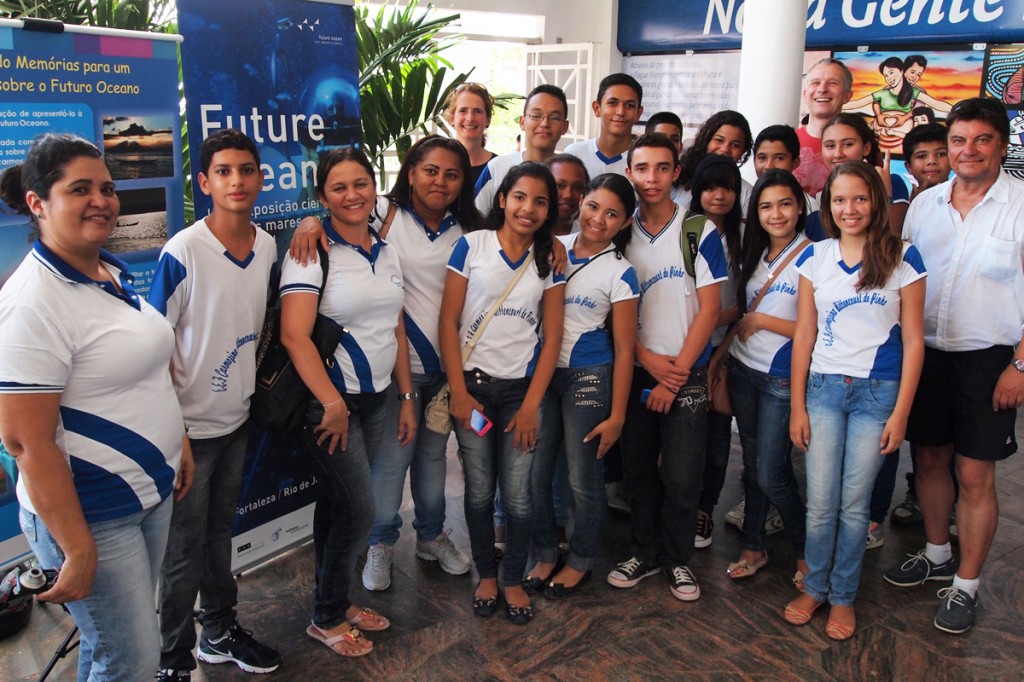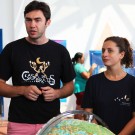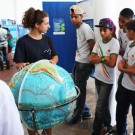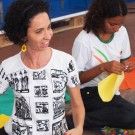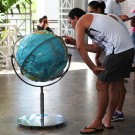German version: See below
Future Ocean Dialogue was a complete success in Fortaleza! That is what our four Brazilian guides have written us after almost 3 weeks of the exhibition. About 3,800 visitors were counted, including not only many school classes and young people but also families and tourists. Especially in the second half of the exhibition, there were many university students, teachers and representatives of NGOs and institutions interested in the exhibition – most of them with some connection to the ocean such as young oceanographers or initiatives like Aquasis, an NGO, with activities such as coastal cleanup or the breeding of young manatees for the protection of the oceans. They were all very enthusiastic and engaged in the dialog with our exhibition team.
“I believe the exhibition has played an important role in conveying the complex scientific topics to the public” says the oceanographer Mariana Paul de Souza Mattos, who worked for three weeks as a visitor guide. “It was nice to see how amazed many people were by the exhibition, especially at the beginning when they caught sight of the relief globe.”
“I met such interesting people during this time, some of which were very experienced, but most of them expanded their knowledge about the beauty and the fragility of the oceans. As guides we had the privilege of observing the journey into the ecosystem ocean and its living environment through the eyes of the visitors. It was amazing to see how they gradually realized how important corals, fish or plankton are for life in the oceans. The globe was in a good position at the beginning of the exhibition and provided with the right introduction for the journey of the visitors. On one day I had a very abstract but enlightening debate there with a couple about the Anthropocene and the role of science and art, evolution and God – in shaping the Future Ocean” says Leopoldo Cavaleri Gerhardinger, a young oceanographer who was not only a guide but also contributed to the success of the first station with the activities of the initiative Memorias do Mar.
We were very pleased about the feedback of our guides and we are already looking forward to the many entries in the guestbook. Also the individual modules, filled with technology and monitors, held out. That was, for us as organizers of the exhibition, a small uncertainty factor. The room in the cultural center Dragao do Mar, the central meeting point in the middle of the city, was well chosen and the blue boxes attracted many visitors. The one problem was the lack of air conditioning, so the modules also had a baptism of fire. With the exception of fisheries management game EcoOcean, which needed a small break in the evening, all others adapted well to the surroundings.
On the 16th of June, the dismantling day of the exhibition, we here in Kiel checked our mobile phones every few minutes. But, no call came! After just three hours we got the message that the boxes were packed and stowed in the container. Another piece of good news. The exhibition manual that our student workers Julia, Katja and Philipp had created and in which each individual dismantling step and the composition of each module was illustrated and described was enough of a guideline. Compliments to the three. The effort here in Kiel was worth it.
Our guides on site have earned a break until the next assignment and we are very hopeful and confident for the next stations.
- Exhibition Guides Leo Gerhardinger & Mariana Mattos, Photo: Friederike Balzereit, Future Ocean
- Photo: Friederike Balzereit, Future Ocean
- Photo: Friederike Balzereit, Future Ocean
- Photo: Friederike Balzereit, Future Ocean
- Outside Dragao do Mar, Photo: Friederike Balzereit, Future Ocean
- Aerial View of Fortaleza, Photo: Friederike Balzereit, Future Ocean
Future Ocean Dialogue war ein voller Erfolg in Fortaleza! Das schreiben uns unsere vier brasilianischen Betreuer nach fast drei Wochen Ausstellungsdauer. Rund 3.800 Besucher haben sie gezählt, darunter viele Schulklassen und junge Leute, aber auch Familien und Touristen. Besonders in der zweiten Hälfte der Laufzeit wurden auch viele Studenten der Universität, Lehrer und Vertreter von NGOs und Institutionen auf die Ausstellung aufmerksam – die meisten mit einem Bezug zum Ozean wie junge Ozeanographen oder Initiativen wie beispielsweise Aquasis, eine NGO, die sich mit Aktionen wie Coastal Cleanup oder der Aufzucht von jungen Seekühen für den Schutz der Ozeane einsetzt. Sie alle zeigten sich begeistert und haben den Dialog mit unserem Ausstellungsteam gesucht.
„Ich glaube, dass die Ausstellung eine wichtige Rolle gespielt hat, die komplexen wissenschaftlichen Themen an die Öffentlichkeit zu bringen“, sagt die Ozeanographin Mariana Paul de Souza Mattos, die drei Wochen lang unsere Besucher geführt hat. „Es war schön zu sehen, mit welchem Erstaunen die viele Leute auf die Ausstellung reagiert haben, besonders schon zum Anfang als sie den Reliefglobus betrachtet haben.“
„Ich habe während der Zeit so viele interessierte Leute getroffen, einige sehr erfahren, aber die meisten haben ihr Wissen über die Schönheit und Zerbrechlichkeit der Ozeane erweitert. Als Guides hatten wir das Privileg durch die Augen der Besucher ihre Reise in das Ökosystem Meer und ihre Lebenswelt zu betrachten. Es war erstaunlich zu sehen, wie sie langsam realisiert haben, wie wichtig Korallen, Fische oder Plankton für das Leben in den Ozeanen sind. Der Globus am Anfang war gut positioniert und hat den richtigen Einstieg für die Reise der Besucher gegeben. An einem Tag habe ich dort mit einem Paar höchst abstrakt aber aufschlussreich argumentiert über das Anthropozän und die Rolle von Wissenschaft und Kunst, Evolution und Gott – um den Ozean der Zukunft zu gestalten,“ sagt Leopoldo Cavaleri Gerhardinger, ein junger Ozeanograph, der nicht nur Guide war, sondern auch mit Aktivitäten der Initiative Memorias do Mar zum Gelingen der ersten Station beigetragen hat.
Das Feedback unserer Guides freut uns sehr und wir sind schon gespannt auf die vielen Eintragungen in das Gästebuch. Auch die einzelnen Module, voll mit Technik und Monitoren, haben durchgehalten. Das war für uns Ausstellungsmacher ein kleiner Unsicherheitsfaktor. Der Raum im Kulturzentrum Dragão do Mar, dem zentralen Treffpunkt mitten in der Stadt, war gut gewählt, die blauen Boxen strahlten schon von weitem und zogen viele Besucher an. Allein, es gab keine Klimaanlage, und so mussten die Module auch eine Feuertaufe bestehen. Bis auf das Fischerei-Managementspiel, den EcoOcean, das abends ab und zu eine kleine Pause brauchte, haben sich aber alle anderen gut akklimatisiert.
Um den Abbautag der Ausstellung am 16. Juni haben wir hier in Kiel die Handys alle paar Minuten gecheckt. Aber, kein Anruf kam! Nach drei Stunden dafür die Info, die Kisten seien verpackt und im Container verstaut. Wieder eine gute Nachricht. Das Ausstellungsmanual, das vor allem unsere Hiwis Julia, Katja und Philipp erstellt hatten und in dem jeder einzelne Schritt und die Zusammensetzung jedes Moduls bebildert und beschrieben war, war Anleitung genug. Kompliment an die drei. Die Mühe hier in Kiel hatte sich gelohnt.
Unsere Guides vor Ort haben sich nun die Pause bis zum nächsten Einsatz redlich verdient und wir sind sehr zuversichtlich für die nächsten Stationen.
